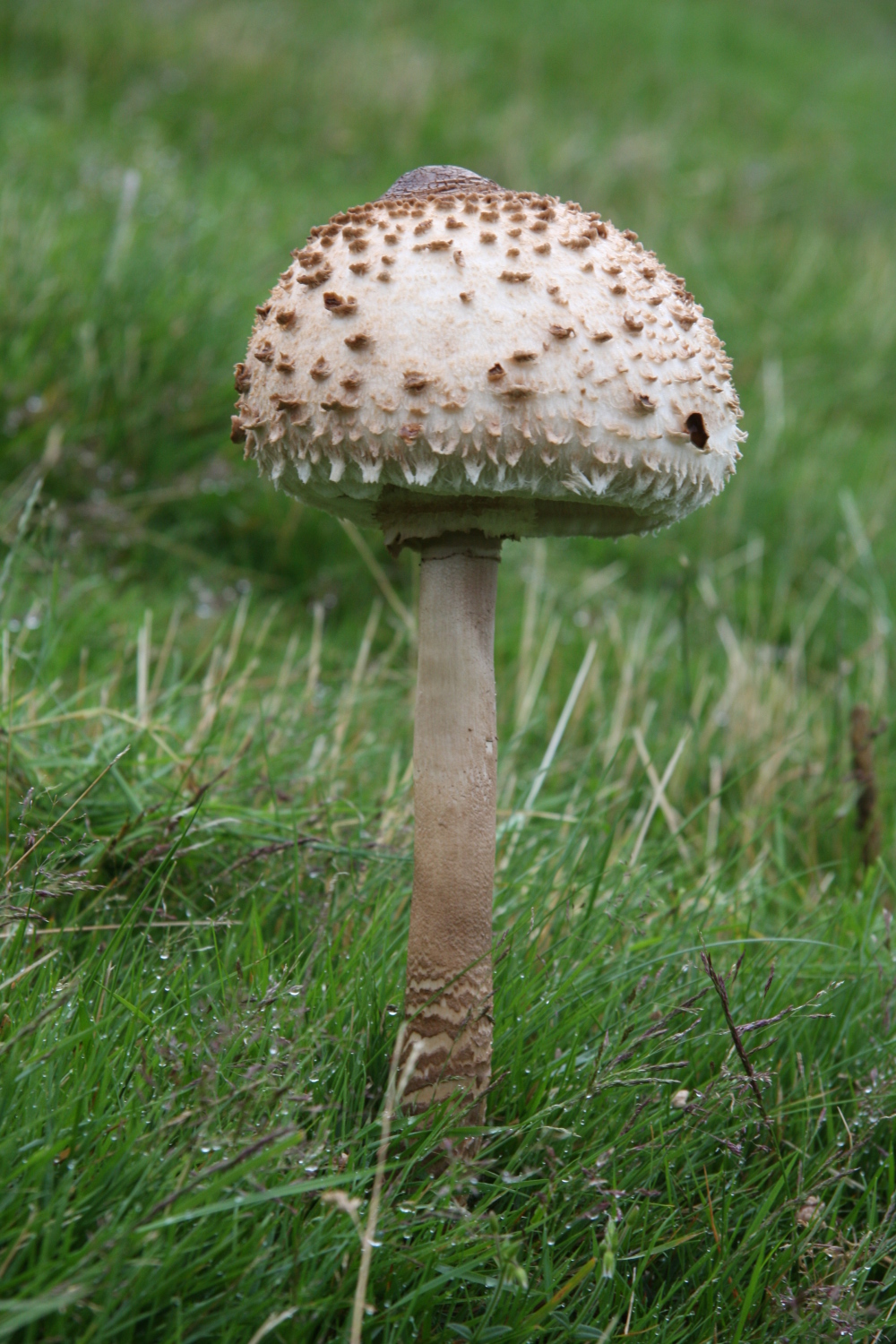- Parasol mushroom
Taxobox
color = lightblue
name = Parasol mushroom
status =
image_width = 220px
regnum = Fungi
divisio =Basidiomycota
classis =Agaricomycetes
subclassis =Homobasidiomycetidae
ordo =Agaricales
familia =Lepiotaceae
genus = "Macrolepiota "
species = "M. procera"
binomial = "Macrolepiota procera"
binomial_authority = (Scop. : Fr.) Sing.mycomorphbox
name = Parasol mushroom
whichGills = free
capShape = flat
hymeniumType=gills
stipeCharacter=ring
ecologicalType=saprotrophic
sporePrintColor=white
howEdible=choice
howEdible2=cautionThe parasol mushroom ("Macrolepiota procera") is a basidiomycete
fungus with a large, prominentfruiting body resembling a lady'sparasol . It is a fairly commonspecies on well-drained soils. It is found solitary or in groups andfairy ring s inpasture s and occasionally in woodland. Globally, it is widespread intemperate regions .Features
The height and cap diameter of a mature specimen may both reach 40 cm, a size truly impressive for the fruiting body of an
agaric . The stipe is relatively thin and reaches full height before the cap has expanded. The stipe is very fibrous in texture which garners it inedible. The surface is characteristically wrapped in asnakeskin -like pattern of scaly growths. The immature cap is compact andegg-shaped , with the cap margin around the stipe, sealing a chamber inside the cap. As it matures, the margin breaks off, leaving a fleshy, movable ring around the stipe. At fullmaturity , the cap is more or less flat, with a chocolate-brownumbo in the centre that is leathery to touch. Dark and cap-coloured flakes remain on the upper surface of the cap and can be removed easily. The gills are crowded, free, and white with a pale pink tinge sometimes present. Thespore print is white. It has a pleasantnutty smell. When sliced, the white flesh may turn a pale pink.Uses
It is a very sought after and popular fungus in Europe, due in part to its large size, seasonal frequency and versatility in the kitchen.
The parasol mushroom is difficult to mistake for any other, especially in regions like eastern Europe where the poisonous look-alike "
Chlorophyllum molybdites " does not occur. Nevertheless, as with picking any fungus for consumption, caution should be exercised at all times.The parasol mushroom may be eaten raw. It is popular soaked in butter. Only the cap of fresh specimens is considered edible.
imilar species
Smaller but similar in appearance is the common
shaggy parasol ("Chlorophyllum rhacodes".) Its edibility is suspect as it causes mild sickness in some people, especially when eaten raw. One must learn to distinguish the two as their geographical ranges overlap.Differences from the parasol mushroom include its smaller dimensions, pungent (fruity) and reddening flesh when cut, lack of patterns on its stipe, and very shaggy cap surface.
"
Macrolepiota mastoidea ", a European species, is yet another very large edible mushroom. Its dimensions are generally smaller than that of "M. procera" and the markings on its stipe less obvious. It is also much rarer.Species of "
Agaricus " have brown spores and the gills of mature specimens are never white.There are a few poisonous species which can be mistaken for "M. procera".
*"Chlorophyllum molybdites ", a species that causes the largest number of annual mushroom poisonings inNorth America due to its close similarity. Faintly green gills and a pale green spore print give it away. Furthermore this mushroom lacks the aforementioned snakeskin pattern that is generally present on the parasol mushroom. [ [http://www.alanmuskat.com/articles/parasol2.htm How to not pass up a parasol – and how not to] ] . Its range is reportedly expanding into Europe. [ [http://www.bio.net/bionet/mm/mycology/1996-September/004542.html Macrolepiota rhacodes and Chlorophyllum molybdites poisoning ] ]
*"Leucocoprinus brunnea ", also found in North America, slowly turns brown when sliced.
*White and immature species of "Amanita " are also a potential hazard. To be sure, one must only pick parasol mushrooms past their button stage. A generalrule of thumb with the parasol mushroom as compared to amanita species is that the parasol mushroom has darker flakes on a lighter surface, whereas amanita species have the opposite, lighter flakes (if there are any) on a darker surface, such as the Panther cap.References
Wikimedia Foundation. 2010.

